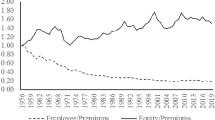Abstract
Capitalization levels in the property-liability insurance industry have increased dramatically in recent years—the capital-to-assets ratio rose from 25% in 1989 to 35% by 1999. This paper investigates the use of capital by insurers to provide evidence on whether the capital increase represents a legitimate response to changing market conditions or a true inefficiency that leads to performance penalties for insurers. We estimate “best practice” technical, cost, and revenue frontiers for a sample of insurers over the period 1993–1998, using data envelopment analysis, a non-parametric technique. The results indicate that most insurers significantly over-utilized equity capital during the sample period. Regression analysis provides evidence that capital over-utilization primarily represents an inefficiency for which insurers incur significant revenue penalties.
Similar content being viewed by others
References
Berger, Allen N., J. David Cummins, and Mary A. Weiss. “The Coexistence of Multiple Distribution Systems for Financial Services: The Case of Property-Liability Insurance.” Journal of Business 70,no. 4 (1997), 515–546.
Berger, Allen N., J. David Cummins, Mary A. Weiss, and Hongmin Zi. “Conglomeration Versus Strategic Focus: Evidence from the Insurance Industry.” Journal of Financial Intermediation 9,no. 4 (2000), 323–362.
Berger, Allen N., and David B. Humphrey. “Measurement and Efficiency Issues in Commercial Banking.” In: Z. Griliches, ed., Output Measurement in the Service Sectors. Chicago: University of Chicago Press, 1992, pp. 245–279.
Charnes, Abraham, William Cooper, Arie Y. Lewin, and Lawrence M. Seiford. Data Envelopment Analysis: Theory, Methodology, and Applications. Norwell, MA: Kluwer Academic Publishers, 1994.
Cummins, J. David. “Multi-Period Discounted Cash Flow Ratemaking Models in Property-Liability Insurance.” Journal of Risk and Insurance 57,no. 1 (1990), 79–109.
Cummins, J. David, and Patricia M. Danzon. “Price, Financial Quality and Capital Flows in Insurance Markets.” Journal of Financial Intermediation 6,no. 1 (1997), 3–38.
Cummins, J. David, and Elizabeth Grace. “Tax Management and Investment Strategies of Property-Liability Insurers.” Journal of Banking and Finance 18,no. 1 (1994), 43–73.
Cummins, J. David, Martin F. Grace, and Richard D. Phillips. “Regulatory Solvency Prediction in Property-Liability Insurance: Risk-Based Capital, Audit Ratios, And Cash Flow Simulation.” Journal of Risk and Insurance (1999), 417–458.
Cummins, J. David, Sharon Tennyson, and Mary A. Weiss. “Consolidation and Efficiency In the U.S. Life Insurance Industry.” Journal of Banking and Finance 23,nos. 2–4 (1999), 325–357.
Cummins, J. David, and Mary A. Weiss. “Analyzing Firm Performance in the Insurance Industry Using Frontier Efficiency Methods.” In: Georges Dionne, ed., Handbook of Insurance Economics. Boston: Kluwer Academic Publishers, 2001, pp. 767–830.
Cummins, J. David, and Mary A. Weiss. “Measuring Cost Efficiency in the Property-Liability Insurance Industry.” Journal of Banking and Finance 17,nos. 2–3 (1993), 463–481.
Cummins, J. David, Mary A. Weiss, and Hongmin Zi. “Organizational Form and Efficiency: An Analysis of Stock and Mutual Property-Liability Insurers.” Management Science 45,no. 2 (1999), 1254–1269.
D'Arcy, Stephen, and Neil A. Doherty. “Adverse Selection, Private Information, and Low Balling in Insurance Markets.” Journal of Business 63,no. 2 (1990), 145–164.
Farrell, M.J. “The Measurement of Productive Efficiency.” Journal of the Royal Statistical Society Series A, 120,no. 3 (1957), 253–281.
Froot, Kenneth. The Financing of Catastrophic Risk. Chicago: University of Chicago Press, 1999.
Gron, Anne. “Capacity Constraints and Cycles in Property-Casualty Insurance Markets.” Rand Journal of Economics 25,no. 1 (1994), 110–127.
Grosskopf, Shawna. “Efficiency and Productivity.” In: H. O. Fried, C. A. K. Lovell, and S. S. Schmidt, eds, The Measurement of Productive Efficiency: New York: Oxford University Press, 1993, 160–196.
Ibbotson Associates. Stocks, Bonds, Bills, and Inflation: 1999 Yearbook. Chicago, 1999.
Jensen, Michael C., and William H. Meckling. “Theory of the Firm: Managerial Behavior, Agency Costs, and Ownership Structure.” Journal of Financial Economics 3,no. 4 (1976), 305–360.
Kunreuther, Howard, and Mark Pauly. “Market Equilibrium with Private Knowledge: An Insurance Example.” Journal of Public Economics 26,no. 3 (1985), 269–288.
Lamm-Tennant, Joan, and Laura Starks. “Stock versus Mutual Ownership Structures: The Risk Implications.” Journal of Business 66,no. 1 (1993), 29–46.
Lovell, C. A. Knox. “Production Frontiers and Productive Efficiency.” In: H. O. Fried, C. A. K. Lovell, and S. S. Schmidt, eds, The Measurement of Productive Efficiency. New York: Oxford University Press, 1993, pp. 3–67.
Merton, Robert C., and Andre F. Perold. “Theory of Risk Capital in Financial Firms.” In: J. M. Stern and D. H. Chew, Jr., eds, The Revolution in Corporate Finance. Malden, MA: Blackwell Business, 1998, pp. 266–282.
Myers, Stewart C., and Nicholas S. Majluf. “Corporate Financing and Investment Decisions when Firms Have Information that Investors Do Not Have.” Journal of Financial Economics 13,no. 2 (1984), 187–221.
Pauly, Mark, Howard Kunreuther, and Paul Kleindorfer. “Regulation and Quality Competition in the U.S. Insurance Industry.” In: J. Finsinger and M. Pauly, eds, The Economics of Insurance Regulation. London: Macmillan, 1986, pp. 65–110.
Shephard, R. W. Theory of Cost and Production Functions. Princeton, N.J.: Princeton University Press, 1970.
Sommer, David W. “The Impact of Firm Risk on Property-Liability Insurance Prices.” Journal of Risk and Insurance 63,no. 3 (1996), 501–514.
Swiss Re. “Deregulation and Liberalization of Market Access: The European Insurance Industry on the Threshold of a New Era in Competition.” Sigma 7, 1996.
Winter, Ralph A. “The Dynamics of Competitive Insurance Markets.” Journal of Financial Intermediation 3,no. 4 (1994), 379–415.
Author information
Authors and Affiliations
Rights and permissions
About this article
Cite this article
Cummins, J.D., Nini, G.P. Optimal Capital Utilization by Financial Firms: Evidence from the Property-Liability Insurance Industry. Journal of Financial Services Research 21, 15–53 (2002). https://doi.org/10.1023/A:1014369617192
Issue Date:
DOI: https://doi.org/10.1023/A:1014369617192




